10 Best Applied AI & ML Courses to Take in 2024
Here are the best courses to learn about Applied AI and ML. Learn with their many applications: self-driving cars, NLP, computer vision, and much more.
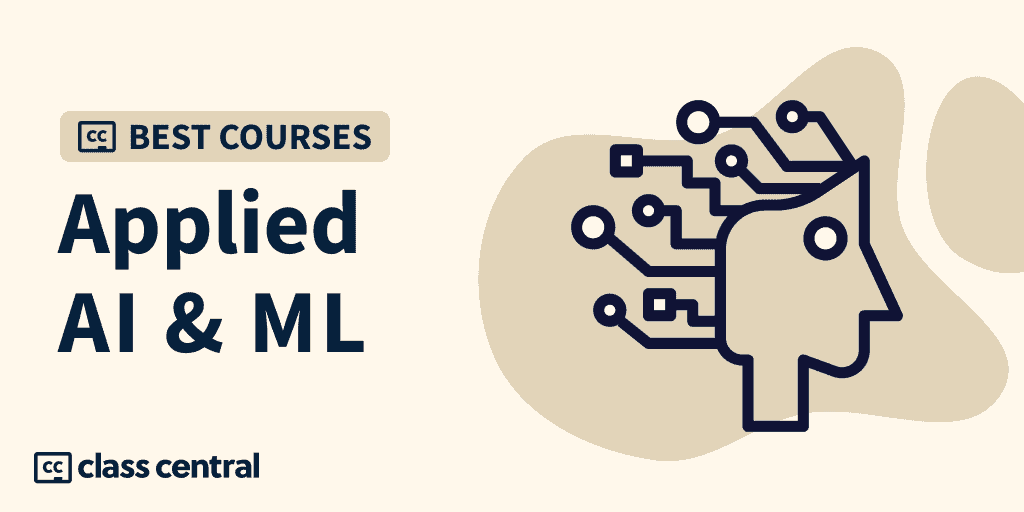
In this guide, I’ve picked the best free online courses, resources and tutorials to learn applied AI and ML. Artificial intelligence and machine learning have numerous applications, from self-driving cars, to natural language processing, to computer vision. Some courses are focused on more advanced learners while others cover the principles and give you an overview of their applications.
If you want to know how I made my picks, you can find the methodology below. But if you’re in a hurry, here are my top picks. Click on one to jump to the course details:
| Course | Workload | In Brief |
| 1. Introduction to Self-Driving Cars (Toronto) | 35 hours | Best Applied AI and ML for advanced learners with engineering and Python skills |
| 2. Convolutional Neural Networks (DeepLearning.AI) | 39 hours | Covers all there is to know about Convolutional Neural Networks (CNNs) |
| 3. Applied Machine Learning in Python (Michigan) | 35 hours | Good for those that know Machine Learning (ML) basics and want to apply them |
| 4. Introduction to Computer Vision (Georgia Tech) | 16 weeks | Complete course packed with Computer Vision (CV) theory and applications |
| 5. Natural Language Processing with Classification and Vector Spaces (DeepLearning.AI) | 20 hours | Practical course about Natural Language Processing (NLP) |
| 6. Structuring Machine Learning Projects (DeepLearning.AI) | 10 hours | Best course for anyone who wants to work in the Machine Learning (ML) industry |
| 7. Introduction to Applied Machine Learning (Alberta) | 7 hours total | Short Machine Learning course to get an overview of ML applications |
| 8. Fundamentals of Machine Learning for Healthcare (Stanford) | 12 hours total | Covers the principles of machine learning in healthcare |
| 9. Machine Learning for Musicians and Artists (Goldsmith, University of London) | 56 hours | Fun course for creatives (artists and musicians) with Machine Learning |
| 10. MLOps Fundamentals (Google) | 17 hours | Go from prototype to deployment with Google Cloud |
What is Applied AI & ML?
You may know a bit about AI and machine learning from here and there. Or perhaps, you’ve actually gotten quite good at them. It’s understandable. These fields are very promising. But now, you don’t really know what to do with the knowledge and skills you’ve learned.
(Just in case you actually don’t know these fields yet, AI is the field of computer science that focuses on allowing computers to demonstrate human-like intelligence. Machine learning is one branch of AI that deals with learning from large amounts of data. If you’re new to these fields, have a look at our Artificial Intelligence or Machine Learning guides.)
The best way to cement your understanding of AI and ML is to put your knowledge into practice. And as it happens, there are countless, powerful ways to apply AI and machine learning. And by doing so, you can develop industry-relevant skills through projects that are not only useful, but fascinating.
According to the Future of Jobs Report from the World Economic Forum, AI and machine learning are expected to be some of the world’s most in-demand skills through 2025.
Course Ranking Methodology
I built this ranking following the now tried-and-tested methodology used in previous rankings (you can find them all here). It involves a three-step process:
First, @manoel and I (@elham) started building this ranking by leveraging Class Central’s database of 100K online courses. We took a look at things like ratings, reviews, and course bookmarks to make a preliminary selection.
This data-driven approach helped us sift through and pinpoint some of the best courses available out there. Most good courses don’t go unnoticed. The very best tend to gather a lot of attention and excellent reviews!
That said, ratings and reviews don’t always tell the whole story. Some courses may be outdated or archived. So the next step was to bring our personal knowledge of online education into the mix.
Second, we used our experience as online learners to evaluate each of our initial picks. We bounced ideas off each other and made iterative improvements to the ranking until we were both satisfied with the end result.
We both come from computer science backgrounds and are prolific online learners, having completed about 45 MOOCs between us. Additionally, Manoel has an online bachelor’s in computer science, and I am currently completing my foundation in computer science. Hence, AI and ML are topics we’re both familiar with.
Third, during our research, we came across courses that felt well-made but weren’t all that popular. If we adopted a purely data-centric approach, we would have to leave those courses out of the ranking, if only because they had fewer enrollments and ratings.
Instead, we took a more holistic approach. We spiced up this list by including a wide variety of Applied AI & ML courses to cater to a diverse range of learners.
After going through this process — combining Class Central data, our experience as lifelong learners, and lots of editing — we arrived at our final ranking. So far, we’ve spent more than 10 hours building this ranking, and we intend to continue updating it in the future.
Course Ranking Statistics
Here are some aggregate stats about the ranking:
- The largest course in this ranking has 400K+ enrollments.
- All together, the courses account for 1.3M enrollments.
- All of the courses are free or free-to-audit.
- 8 courses are advanced or intermediate level, while the rest are beginner-friendly.
- The most represented provider in this ranking is Coursera.
Without further ado, let’s go through the top picks.
1. Introduction to Self-Driving Cars (University of Toronto)
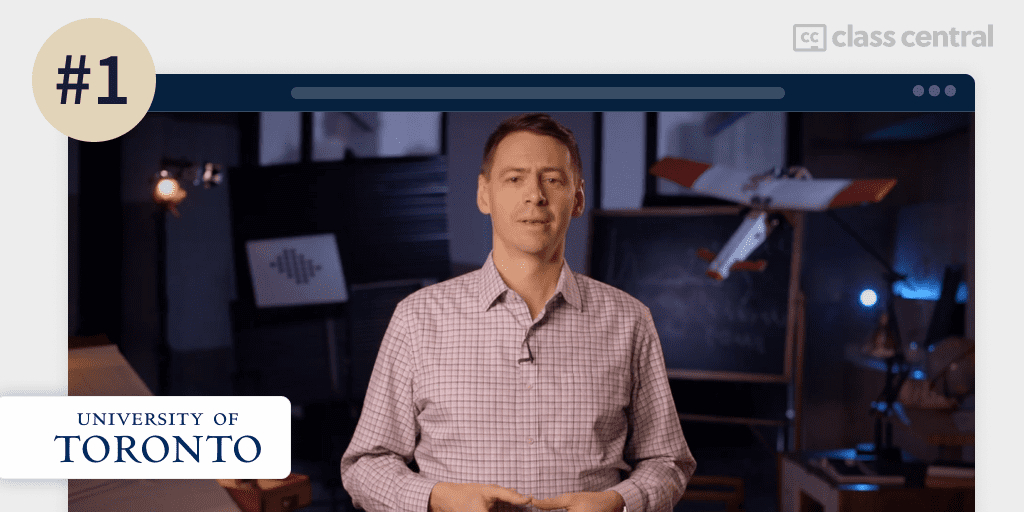
My #1 pick for the best AI / ML course is Introduction to Self-Driving Cars by the University of Toronto.
This course is my top pick because it stretches the limits of your skills on something pretty awesome and innovative. You’ll learn all about the terminology, design considerations, and safety assessment of self-driving cars.
But beware, it is an advanced course; you should have a background in mechanical engineering, computer and electrical engineering, or robotics. Additionally, you should have programming experience in Python 3 and familiarity with Linear Algebra, Statistics, Calculus, and Physics. You will also need specific hardware and software specifications which you can find in the course link.
What You’ll Learn
This course is designed to introduce you to the world of autonomous vehicles or more simply, self-driving cars. You’ll start with the history and recent progress made in the field.
Then, you’ll define what driving means and list out its element: all those things that you do automatically when you’re behind the steering wheel — identifying road signs, vehicles and pedestrians, predicting their actions, and all sorts of things that we take for granted!
As self-driving vehicles have emerged only recently, there is no one standard of system architecture. Hence, you’ll go through the different ways to design a basic self-driving car hardware configuration, discuss a generic software stack to decompose the driving task into manageable components, and discuss how to represent the perceived environment for decision-making.
As the self-driving domain matures, assuring the public and regulators that self-driving cars are safe becomes of more and more importance to self-driving developers (remember when Google’s first self-driving car crash made the news?).
You’ll study how to incorporate safety considerations into autonomous vehicle design, both in software and hardware. From there, we will move into vehicle modeling and control, like telling the car where it is, how fast it’s going, how to follow a desired route, and how to execute challenging maneuvers. Finally, you’ll test the limits of your control design and learn the challenges inherent in driving at the limit of vehicle performance.
How You’ll Learn
This course is 7 weeks long, with 35 hours worth of material. You’ll learn a lot from the plethora of video lectures and reading materials provided by the course, along with weekly graded quizzes to test your knowledge.
There will also be two graded programming assignments to complete, as well as a final project. The final project is a realistic hands-on project where you’ll have to develop control code to navigate a self-driving car around a race track in the CARLA simulation environment, truly stretching your skills to the limits as well as being a great learning experience!
The graded assignments are only available to paying learners.
| Institution | University of Toronto |
| Provider | Coursera |
| Instructors | Steven Waslander and Jonathan Kelly |
| Level | Advanced |
| Workload | 35 hours total |
| Enrollments | 118K |
| Rating | 4.7 / 5.0 (2.7K) |
| Certificate | Paid |
Fun Facts
- Steven Waslander is a leading authority on autonomous aerial and ground vehicles, including multirotor drones and autonomous driving vehicles.
- He received his Ph.D. in Aeronautics and Astronautics from Stanford University in 2007.
- Jonathan Kelly is the Director of the Space & Terrestrial Autonomous Robotic Systems (STARS) Laboratory, where he has developed robots that fly, drive, swim, and grasp.
If you’re interested in this course, you can find more information about the course and how to enroll here.
2. Convolutional Neural Networks (DeepLearning.AI
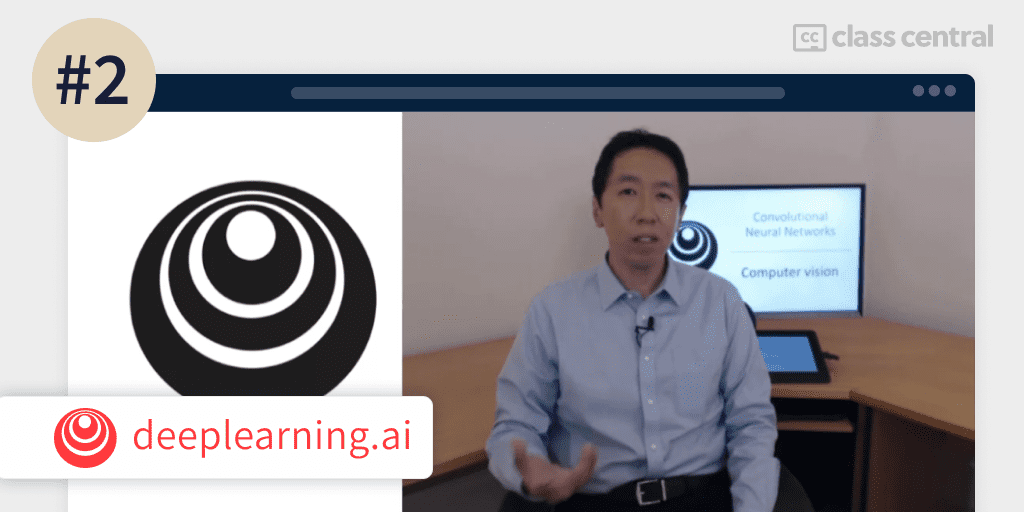
My second pick for the best applied AI / ML course goes to Convolutional Neural Networks by DeepLearning.AI.
In this course, you’ll understand how computer vision has evolved and explore its exciting applications — from autonomous driving to face recognition to reading radiology images and more!
By the end of the course, you’ll be able to build a convolutional neural network, including recent variations such as residual networks, apply convolutional networks to visual detection and recognition tasks, and use neural style transfer to generate art and apply these algorithms to a variety of image, video, and other 2D or 3D data, all in TensorFlow.
The prerequisites of this course are intermediate Python skills and a basic grasp of linear algebra and machine learning.
What You’ll Learn
The course begins with the fundamentals of Convolutional Neural Networks (CNN). CNNs are highly efficient at classifying image-based data. You’ll learn all about the architecture and mathematics behind CNNs (wonder why they are called convolutional?), and then implement your own deep neural model to solve multi-class image classification problems.
Once you have gotten the basics of CNNs down, you’ll explore and review several case studies about effective convolutional neural networks. You’ll look at a few models like the LeNet-5, the ResNet, and the Inception network to gain insight into the fascinating nature of these models. Computer vision research has advanced quickly in the last few years, and one of the best ways to write good code and have good ideas is by reading other people’s codes and ideas.
Object detection is one of the areas of computer vision that has gotten so much better and more exciting recently. But first, object localization. Let’s say you see a cute cat. You recognize that there is a body of matter that is cat surrounded by not-cat things. That’s the problem object localization aims to solve. Once that is solved, you’ll use ConvNet and U-nets to identify objects within an image.
The final part of the course — and arguably the most exciting — is all about face recognition and art generation. You’ll build a Siamese network to recognize faces and then use deep ConvNets for neural style transfer, recreating an image in the style of another.
How You’ll Learn
This course is 4 weeks long, with 39 hours worth of material. You’ll learn primarily from the lecture videos and the resources the course provides.
If you are paying for the certificate, each week comes with a quiz as well as one or two programming assignments that you’ll have to complete in order to apply your knowledge of convolutional neural networks into practice.
| Institution | DeepLearning.AI |
| Provider | Coursera |
| Instructors | Andrew Ng, Kian Katanforoosh, and Younes Bensouda Mourri |
| Level | Intermediate |
| Workload | 39 hours total |
| Enrollments | 402K |
| Rating | 4.9 / 5.0 (40K) |
| Certificate | Paid |
Fun Facts
- Andrew Ng is the co-founder and head of Google Brain and was the former chief scientist at Baidu.
- He also co-founded Coursera, before creating DeepLearning.AI.
If you’re interested in this course, you can find more information about the course and how to enroll here.
3. Applied Machine Learning in Python (University of Michigan)

My third pick for the best applied AI / ML course is Applied Machine Learning in Python by the University of Michigan.
This beginner-friendly course teaches you the machine learning techniques and concepts needed for everyday work. By the end of the course, you’ll know the difference between supervised and unsupervised learning and when to apply them, select specific features for your model to train on, and write Python code to carry out an analysis.
In order to be successful in this course, you will need to know how to program in Python and be familiar with libraries such as numpy, pandas, and matplotlib.
What You’ll Learn
The course begins with an introduction to essential machine learning (e.g., supervised vs. unsupervised) concepts and how it is different from descriptive statistics. Then, you’ll start with your first basic classification algorithm, k-nearest neighbors. You’ll learn how k-nearest neighbors classify an unknown data point by looking at the closest points around it, and then, you’ll implement the algorithm using the scikit-learn library.
In the second module, you’ll dive into the supervised learning methods for classification and regression. An example of classification is figuring out if an animal is a cat or dog, while regression is predicting the price of a 100-room mansion. You’ll learn an important lesson on model complexity and generalization. More complex models are more obscure to humans — it’s hard to understand the reasoning behind its predictions — while more generalized models are great for a variety of ML tasks but suffer from being too mild in their predictions. Hence, you’ll learn when to use one ML model over another.
How do we tell if our model satisfactorily predicts data? Module three covers the evaluation and model selection methods that you can use to help understand and optimize the performance of your machine learning models. For example, you’ll learn how accuracy can be a misleading evaluation of model performance when you learn about false positives.
The final module discusses more advanced supervised learning methods: tree ensembles and neural networks. You’ll study how these different algorithms tweak their own parameters using data to improve their predictions. Lastly, you’ll learn to avoid the dastardly data leakage — ’cheating’ by giving your model information it shouldn’t know and hence produces bias.
How You’ll Learn
This course is 4 weeks long, with 35 hours worth of material. The course provides many lecture videos and reading materials.
As the name of the course implies, you’ll apply a lot of what you’ll learn in the labs. If you are paying for the certificate, you’ll have access to the weekly quiz and assignments which will drill in what the course instructors have taught you.
| Institution | University of Michigan |
| Provider | Coursera |
| Instructor | Kevyn Collins-Thompson, Christopher Brooks, Daniel Romero, and V. G. Vinod Vydiswaran |
| Level | Intermediate |
| Workload | 35 hours total |
| Enrollments | 254K |
| Rating | 4.6 / 5.0 (8K) |
| Certificate | Paid |
Fun Facts
- The instructors recommend Introduction to Machine Learning with Python as a textbook guide, although not necessary to have.
- The course has hundreds of bookmarks on Class Central.
If you’re interested in this course, you can find more information about the course and how to enroll here.
4. Introduction to Computer Vision (Georgia Institute of Technology)
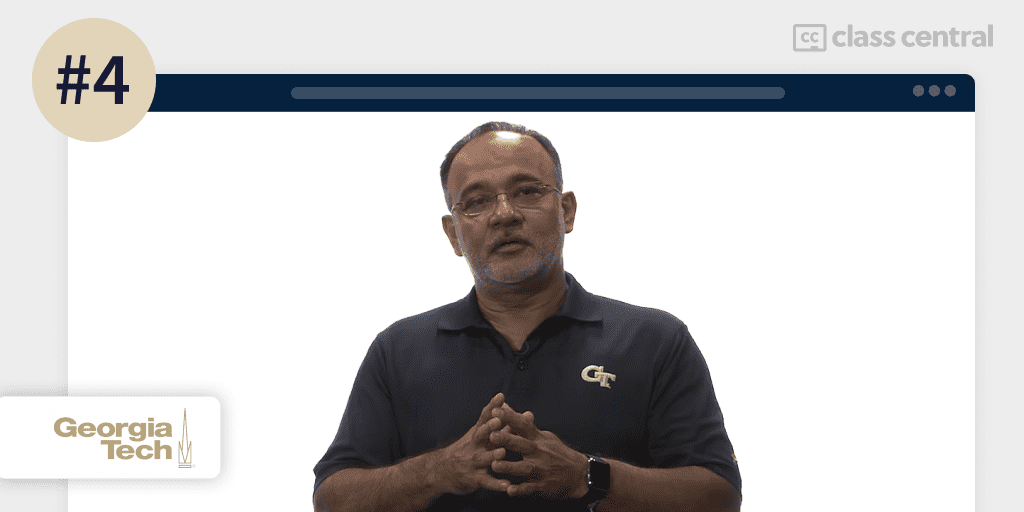
Teaching a computer to see and interpret images is fascinating, but before showing computers what images are, we too must know how images work.
Introduction to Computer Vision by Georgia Institute of Technology aims to fill in that hole. This content-packed course will give you insight into the fundamentals of analyzing images and extracting information from images. For example, you’ll learn about feature detection, motion tracking, camera calibration, image stabilization, and so much more.
To take this course, you’ll need to know some data structures (I have a data structures ranking) and have good working knowledge of MatLab and/or Python with NumPy. You also require some math, like linear algebra and vector calculus, and experience with signal processing is helpful but not necessary.
What You’ll Learn
The course is structured into 10 units: Introduction; Image Processing For Computer Vision; Camera Models and Views; Features and Matching; Lightness and Brightness; Image Motion; Motion and Tracking; Classification and Regression; Miscellaneous Operations; Human Vision.
You can think of computer vision as being a relationship between three ways of thinking: computational model, algorithms, and real images.
Computational model is the math behind processing images, algorithms are the implementation of the math, and lastly, real images are the application of the algorithm. The course goes through all three aspects, especially the last one.
Afterwards, you’ll do some image processing because you have to manipulate images to do a variety of types of interaction with them later. You’ll also need to learn about the geometry of cameras and camera models, and what happens when you have multiple views and how you can relate them to each other.
Ascending to a high-level view, you’ll be introduced to features, which is computing something about one image and figuring out where in the other image those same features occur. Once you get that down, there’s a lot you can do in terms of thinking about either transforming images or computing geometry between them.
How does light interact with material before it arrives at your imaging sensor to produce a beautiful picture? The course spends some time talking about how images are formed in the first place.
Videos are essentially sequences of images, so defining motion entails defining how pixels between images change which will then enable us to start tracking the object.
The course also discusses a little bit about machine learning, like classification and recognition, but the bulk of the courses is dedicated to computer vision as it pertains to traditional AI rather than machine learning and deep learning.
How You’ll Learn
This course is 16 weeks long, as it includes a lot of video lectures that are well-produced. There are also multiple practice quizzes you can complete to test your understanding.
The highlight of this course is its emphasis on practical application. Often, real-world images have their own little issues and quirks that confuses even the most advanced of algorithms. Hence, a lot of perseverance and experimentation are necessary to get good results. You’ll experience this first-hand in the 8 problem sets provided.
| Institution | Georgia Institute of Technology |
| Provider | Udacity |
| Instructors | Irfan Essa, Aaron Bobick, and Arpan Chakraborty |
| Level | Intermediate |
| Workload | 16 weeks long |
Fun Facts
- The course has 4.8K bookmarks on Class Central.
- Irfan Essa, the instructor, is a Distinguished Professor of Computing at Georgia Tech. He worked with Google to develop a video stabilization algorithm which is currently being deployed on YouTube.
- This course is offered as part of Georgia Tech’s Online Master of Computer Science (OMSCS).
If you’re interested in this course, you can find more information about the course and how to enroll here.
5. Natural Language Processing with Classification and Vector Spaces (DeepLearning.AI)
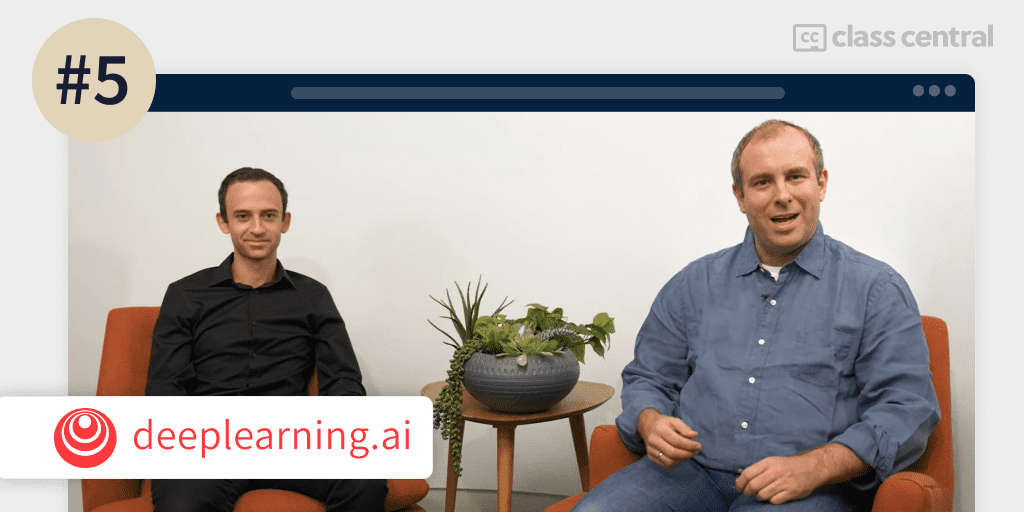
Let’s say you have 1,000 product reviews written by buyers. Can you build a system to automatically go through all of these product reviews and figure out what percentage are positive and negative? Natural Language Processing with Classification and Vector Spaces will teach you how to do that and lots more on natural language processing.
By the end of this DeepLearning.AI course, you’ll have performed sentiment analysis of tweets, discovered and visualized relationships between related words, and developed an English to French translation algorithm.
What You’ll Learn
Usually, when performing machine learning, you’ll have an array of real-world features like price, height, and color. But texts are hardly tangible objects, so how do we represent text as features to feed our machine learning algorithm? To handle this, you’ll turn text into vectors and feed the vectorized text to a classifier that will tell if they have positive or negative connotations.
Another thing you’ll learn in this course is vector space models which captures semantic meaning and relationships between words. Okay, let me put that simply: when I say the word dog, you might think of ‘canine’, ‘bark’, ‘bite’, ‘wag’. Vector space models help teach a computer this linguistic intuition, which will help them in search-related applications like information retrieval, indexing, relevancy ranking, and information filtering.
The final section of this course touches on something fascinating: machine translation and document searching. More specifically, you’ll use locality-sensitive hashing — putting words surrounded by other similar words into the same bucket. You’ll end the course by writing an algorithm that translates English to French.
How You’ll Learn
This course is 4 weeks long, with each week taking 5 hours to complete. You’ll learn from the lecture videos and reading materials.
If you are paying for the certificate, you will have access to the labs, as well as the weekly practice quiz and a graded coding assignment.
| Institution | DeepLearning.AI |
| Provider | Coursera |
| Instructors | Younes Bensouda Mourri, Łukasz Kaiser and Eddy Shyu |
| Level | Intermediate |
| Workload | 20 hours total |
| Enrollments | 103K |
| Rating | 4.6 / 5.0 (3.3K) |
| Certificate | Paid |
Fun Facts
- This course is the first course of the Natural Language Processing Specialization. By the end of this Specialization, you will have designed NLP applications that perform question-answering and sentiment analysis, created tools to translate languages and summarize text, and even built a chatbot!
- Younes Bensouda Mourri is an AI instructor at Stanford University, who also helped build the Deep Learning Specialization.
- Łukasz Kaiser is a Staff Research Scientist at Google Brain and the co-author of Tensorflow, the Tensor2Tensor and Trax libraries, and the Transformer paper.
If you’re interested in this course, you can find more information about the course and how to enroll here.
6. Structuring Machine Learning Projects (DeepLearning.AI)
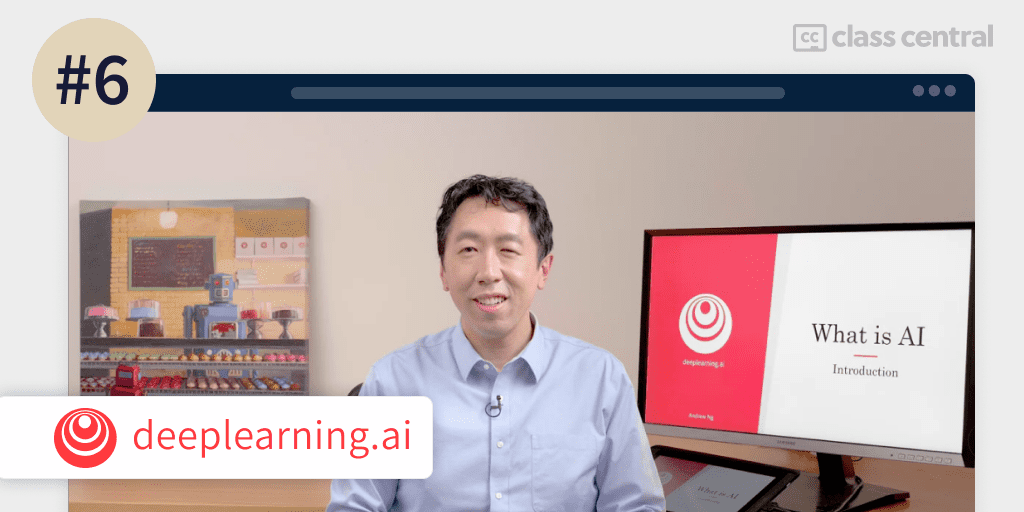
Structuring Machine Learning Projects by DeepLearning.AI aims to provide you with industry experience that you might otherwise get only after years of ML work experience, all of it taught by the legendary ML instructor Andrew Ng! You’ll learn how to lead your team on a successful machine learning project through practical advice.
By the end of the course, you’ll be able to diagnose errors in a machine learning system, prioritize strategies for reducing errors, understand complex ML settings such as mismatched training/test, and apply end-to-end learning, transfer learning, and multi-task learning.
What You’ll Learn
As the aim of this course is to provide you with industry-standard knowledge and intuition, you’ll begin by understanding what machine learning strategy is.
Having a machine learning strategy is essential. For example, let’s say you have a model that classifies cats with 90% accuracy, but this isn’t enough for you. How can we go about improving the model performance? Well, we could collect more training data, or train the algorithm model, or try a different optimization algorithm, or switch to a different model architecture, and the list of potential improvements goes on and on. A machine learning strategy acts as a distant lighthouse in a sea of time-consuming ideas — it points you in the direction of the most promising things to try and hence saves time, effort, and money.
Hence, you’ll streamline and optimize your ML production workflow by implementing and following strategic guidelines before, during, and after the ML process. You’ll set goals based on attainable metrics, split your dataset proportionately, compare your ML performance with human-level performance, recognize bias, variance, and data mismatch as it happens, and learn when to use multi-task, transfer, and end-to-end deep learning in your project.
How You’ll Learn
This course is 2 weeks long, with each week taking 5 hours to complete. You’ll learn primarily from lecture videos, although lecture notes are also provided. There are two graded assignments that you’ll have to complete if you are paying for the certificate.
| Institution | DeepLearning.AI |
| Provider | Coursera |
| Instructors | Andrew Ng, Younes Bensouda Mourri, and Kian Katanforoosh |
| Level | Beginner |
| Workload | 10 hours total |
| Enrollments | 371K |
| Rating | 4.8 / 5.0 (48K) |
| Certificate | Paid |
Fun Facts
- Structuring Machine Learning Projects is the third course of the Deep Learning Specialization.
- This course can also act as a standalone course for learners who have basic machine learning knowledge.
If you’re interested in this course, you can find more information about the course and how to enroll here.
7. Introduction to Applied Machine Learning (Alberta Machine Intelligence Institute)
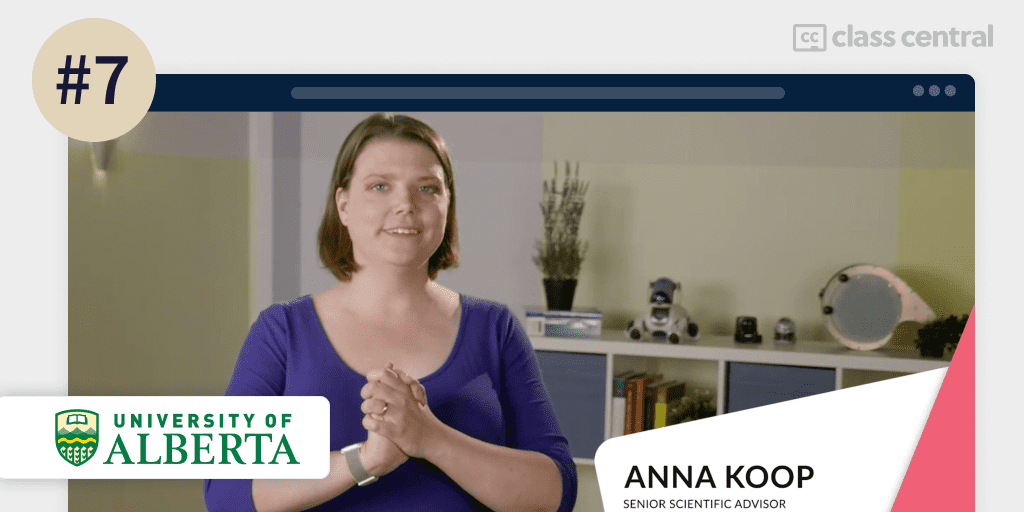
If you’re a non-technical professional who wants to see what the hype with machine learning is all about, this course is for you.
Introduction to Applied Machine Learning by Alberta Machine Intelligence Institute is a general introduction to machine learning going over the big concepts of a successful machine learning project. It focuses less on building new algorithms or proving theorems, favoring instead applying machine learning solutions to real-world problems.
You’ll be introduced to key terms and will learn how to come up with good machine learning problems. By the end of the course, you will be able to clearly define a business need as a machine learning problem and turn it into a machine learning application.
What You’ll Learn
Machine learning. AI. Data science. Deep learning. These are the latest buzzwords, but what do they all mean exactly? The course begins by clearing up the definition of each of these terms as well as some common misconceptions regarding them. Then, the course introduces you to the three kinds of machine learning: supervised, unsupervised, and reinforcement.
Next, you’ll dive deeper into the aspects of machine learning. For example, you’ll understand how machine learning differs from human learning. Afterward, you’ll learn how to turn and refine a business need into a machine learning problem and get the raw data for the problem. Don’t worry; plenty of examples will be provided in the lectures.
Previously, you’ve learned that machine learning can’t happen without data. But where do we get data, and what kind of data? You’ll answer these questions as well as discuss the ethical issues regarding the acquisition of data. Lastly, you’ll learn about the data pipeline and why it is essential to have a squeaky clean pipeline.
The course ends with the Machine Learning Process Lifecycle (MLPL), a framework that captures the iterative process of developing a Machine Learning solution for a specific problem. After understanding the MLPL, you’ll analyze its application in a case study to get a glimpse of what a reasonable machine learning project might look like.
How You’ll Learn
This course includes 7 hours worth of material. Study material consists of video lectures and readings. If you’re a paid learner, there are no programming assignments to be completed. Instead, you’ll have access to the weekly quizzes that will test you on the topics covered.
| Institution | Alberta Machine Intelligence Institute |
| Provider | Coursera |
| Instructor | Anna Koop |
| Level | Intermediate |
| Workload | 7 hours total |
| Enrollments | 20K |
| Rating | 4.7 / 5.0 (680) |
| Certificate | Paid |
Fun Facts
- This course is the first course in the Machine Learning: Algorithms in the Real World Specialization, with the course after it being Machine Learning Algorithms: Supervised Learning Tip to Tail.
- Anna Koop is a Research Associate at the University of Alberta with an interest in programming and autonomous robots that can adapt to their environment.
If you’re interested in this course, you can find more information about the course and how to enroll here.
8. Fundamentals of Machine Learning for Healthcare (Stanford University)
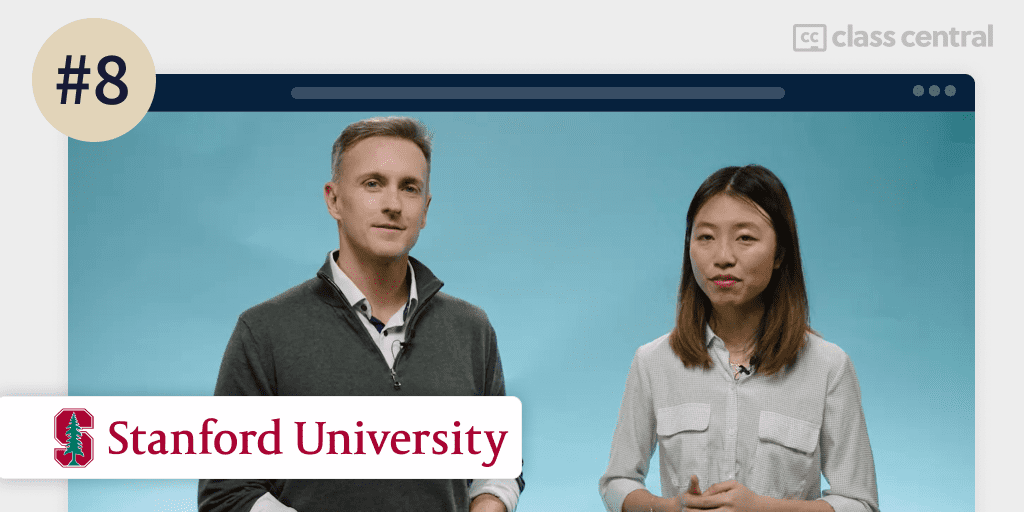
Machine learning and AI hold the potential to revolutionize healthcare, with applications ranging from automated screening and diagnosis to genomic analysis to robotics and more.
But, this can only happen when many in the system have basic competencies in both healthcare and machine learning concepts and principles. Stanford University’s Fundamentals of Machine Learning for Healthcare aims to give you exactly that.
This course covers the principles and concepts of machine learning in healthcare, and the meaning behind common terminology, including machine learning, deep learning and neural networks, all through the lens of applications in medicine.
The course will empower anyone with an engineering background in healthcare, health policy, pharmaceutical development, as well as data science with the knowledge to evaluate and use these technologies critically.
What You’ll Learn
The course begins by discussing what machine learning is and why it is useful in healthcare. Then, you’ll dive deep into the fundamental concepts and principles in machine learning, from how to define machine learning problems, train machine learning models, and different types of machine learning models, from simple regression to complex deep learning.
Next, you’ll spend a lot of time on metrics, evaluation, and best practices in clinical machine learning. For instance, let’s say we have a genetic condition that only affects 0.1% of humans. If we developed a model that correctly diagnoses patients 99.9% of the time, we might call our trial a success. But wait, the machine could just diagnose every patient as healthy, and it would still technically be correct 99.9% of the time! This is why we must be careful when taking a look at our data and how we can measure our model’s performance, especially since someone’s life might be at stake. The course will enlighten you with common challenges, pitfalls, and suggested strategies for handling these situations.
When you work in healthcare, you’re seldom alone. And you’ll also work with many people from other disciplines and backgrounds. The course will discuss the critical components of project development for diverse, multi-disciplinary teams to collaborate effectively. Finally, the course concludes by explaining the human factors and societal impacts of machine learning and the ethical issues one might face.
How You’ll Learn
This course is 7 weeks long, with 12 hours worth of material. You’ll learn a lot from the video lectures and reading materials supplied in the course.
There are plenty of practice exercises that you can do throughout the course to test your understanding, but there is only one graded final assessment that you’ll have to complete to pass the course if you are paying for the certificate.
| Institution | Stanford University |
| Provider | Coursera |
| Instructors | Matthew Lungren and Serena Yeung |
| Level | Beginner |
| Workload | 12 hours total |
| Enrollments | 10K |
| Rating | 4.8 / 5.0 (200) |
| Certificate | Paid |
Fun Facts
- This course is the third course in the AI in Healthcare Specialization. It discusses the current and future applications of AI in healthcare with the goal of learning to bring AI technologies into the clinic safely and ethically.
If you’re interested in this course, you can find more information about the course and how to enroll here.
9. Machine Learning for Musicians and Artists (Goldsmith, University of London)

Machine learning is not all lifeless 1s and 0s, as proven by Machine Learning for Musicians and Artists.
This course by University of London will introduce you to the fundamentals of machine learning and its applications in the world of creative arts, with a focus on human gesture, musical audio, and other real-time data. By the end of the course, you’ll know both the theory and practice skills needed to apply machine learning in the Arts.
No prior knowledge of machine learning, mathematics, or other topics is required. Having some text-based or visual programming background (e.g. an introduction to ChucK, Processing, Max/MSP, PD, or some other environment) is recommended but not strictly necessary.
What You’ll Learn
The course begins with an introduction to machine learning. You’ll learn all about the essential technical aspects of machine learning, like the different flavors of machine learning, feature extraction, and the machine learning pipeline.
However, as the course name implies, you’ll consider all of these through the lens of artistic expression. For example, one of the algorithms you’ll learn is Gesture Variation Follower, used for real-time human gesture recognition.
Additionally, you’ll have hands-on experience working with some of the tools used in machine learning (specifically Wekinator) and apply it to real-time audio, video, game controllers, sensors, and other creative forms of expression!
How You’ll Learn
This course consists of 7 sessions, with 8 hours of work per session, although some of the sessions are only accessible to premium students. You’ll learn from video lectures as well as hands-on practice.
| Institution | Goldsmith, University of London |
| Provider | Kadenze |
| Instructor | Rebecca Fiebrink |
| Level | Beginner |
| Workload | 56 hours total |
| Rating | 4.8 / 5.0 (85) |
| Certificate | Paid |
Fun Facts
- The course has 32.3K bookmarks on Class Central.
- Rebecca Fiebrink is a Professor at the Creative Computing Institute at University of the Arts, London. Her research combines techniques from human-computer interaction, machine learning, and signal processing to help design new digital musical instruments and gestural interfaces for gaming and accessibility.
If you’re interested in this course, you can find more information about the course and how to enroll here.
10. MLOps (Machine Learning Operations) Fundamentals (Google)
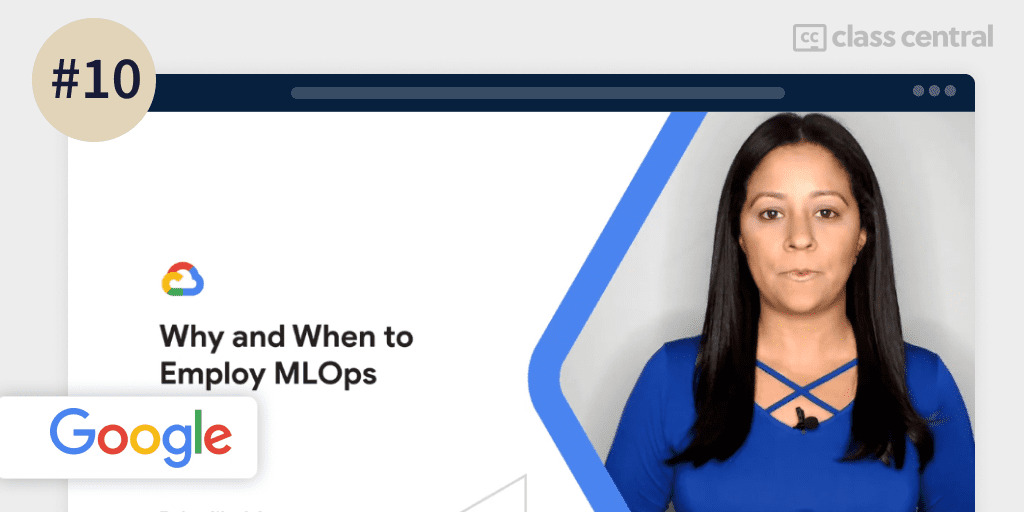
If you’re someone who wants to go quickly from a machine learning prototype to business-ready production, MLOps (Machine Learning Operations) Fundamentals might suit your needs.
In case you are not familiar with MLOps, it is a discipline focused on the deployment, testing, monitoring, and automation of ML systems in production. Specifically in this course, you’ll learn about the tools and best practices for deploying, evaluating, monitoring and operating production ML systems on Google Cloud.
What You’ll Learn
In this course, you’ll learn about the MLOps and why we should care about it. You’ll get a high-level overview of machine learning from an operations perspective — from defining the problem all the way to the solution. As this course is a Google course, you’ll learn about the ins and outs of Google Cloud and its various services — more specifically, its AI Platform.
Beginning with a humble Jupyter notebook, the course will teach you how to train and tune your models on Google’s AI Platform and turn it into a machine learning pipeline. You’ll see how the Kubeflow pipeline can automate most of the machine learning process for you. Finally, you’ll also learn how to integrate this pipeline in a continuous integration stack.
How You’ll Learn
This course is 4 weeks long, with 17 hours of material. You’ll learn from studying the video lectures, hands-on lab hosted on Qwiklabs, and weekly quizzes. Do note that some of the labs are buggy according to user reviews and are only accessible to paying students.
| Institution | |
| Provider | Coursera |
| Level | Intermediate |
| Workload | 17 hours total |
| Enrollments | 25K |
| Rating | 4.0 / 5.0 (340) |
| Certificate | Paid |
Fun Facts
- This course is part of the Preparing for Google Cloud Certification: Machine Learning Engineer Specialization, which aims to help you prepare for the Google Cloud Professional Machine Learning Engineer certification.
If you’re interested in this course, you can find more information about the course and how to enroll here.







